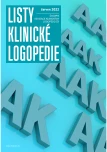NON-VERBAL COMMUNICATION OF INFANTS BORN PREMATURELY AS A METHOD OF ASSESSING THE FUNCTIONAL STATE OF THE CENTRAL NERVOUS SYSTEM
Authors:
Červenková Barbora 1
Published in:
Listy klinické logopedie 2022; 6(1): 4-9
Category:
Main topic
doi:
https://doi.org/10.36833/lkl.2022.005
Overview
Non-verbal communication usually complements verbal communication. The means of non-verbal communication usually include gestures, body or head movements, body posture, facial expression, eye view, proxemics and body contact, tone of voice and other aspects of our appearance or the space we inhabit. However, we can obtain a much wider range of information from the non-verbal communication of infants born prematurely. Experts, doctors (neurologist, neonatologist) and development specialists from various non-medical professions (speech and language therapist, physiotherapist, occupational therapist, psychologist) need to investigate the current functional state, during hospitalisation, of the central nervous system in a baby born prematurely, to predict the neurodevelopmental deficits of various types and degrees. Premature birth increases the risk of sensory or physical deficits and neurodevelopmental disorders. With the help of several basic tools, it is possible to evaluate, for example, the neurological development or behavioural development of the infant. This review article aims to present the currently used methods for determining the functional state of the central nervous system during hospitalisation in babies born prematurely, which can be administered by a speech and language therapist, but also by other professionals from the medical and non-medical professions.
Keywords:
non-verbal communication – premature baby – neonatal neurobehavioural assessment – observation of spontaneous movement
Sources
- ALS, H., TRONICK, E., ADAMSON, L. a BRAZELTON, T. B., 1976. The behavior of the full-term but underweight newborn infant. Developmental Medicine & Child Neurology, 18 (5), s. 590-602. DOI: 10.1111/j.1469-8749.1976.tb04205.x.
- ALS, H., 1982. Toward a synactive theory of development: promise for the assessment and support of infant individuality. Infant Mental Health Journal, 3 (4), s. 229-243. DOI: 10.1002/1097-0355(198224)3:4<229::AID-IMHJ2280030405>3.0.CO;2-H.
- ALS, H., 1986. A Synactive Model of Neonatal Behavioral Organization: Framework for the Assessment of Neurobehavioral Development in the Premature Infant and for Support of Infants and Parents in the Neonatal Intensive Care Environment. Physical & Occupational Therapy In Pediatrics, 6 (3‒4), s. 3-53. [cit. 19. 2. 2022]. Dostupné z: https://www.tandfonline.com/toc/ipop20/6/3-4? av=tocList
- ALS, H., DUFFY, F. U. a MCANULTY, G. B., 1988. The APIB, an assessment of functional competence in preterm and full-term newborns regardless of gestational age at birth: II. Infant Behavior and Development, 11 (3), s. 319-331. DOI: 10.1016/0163-6383(88)90017-3.
- ALS, H., BUTLER, S., KOSTA, S., MCANULTY, G. B., 2005. The Assessment of Preterm Infants' Behavior (APIB): Furthering the understanding and measurement of neurodevelopmental competence in preterm and full-term infants. Mental Retardation and Developmental Disabilities Research Reviews. 11 (1), s. 94-102. DOI: 10.1002/mrdd.20053.
- CIONI, G. a PRECHTL, H. F. R., 1990. Preterm end early postterm motor behaviour in low risk premature infants. Early Human Development, 23 (3), s. 159-191. DOI: 10.1016/0378-3782(90)90012-8.
- DARSAKLIS, V., SNIDER, L. M., MAJNEMER, A. a MAZER, B., 2011. Predictive validity of Prechtl's method on the qualitative assessment of general movements: a systematic review of the evidence. Developmental Medicine & Child Neurology, 53 (10), s. 896-906. DOI: 10.1111/j.1469-8749.2011.04017.x.
- EL-DIB, M., MASSARO, A. N., GLASS, P. a ALY, H., 2011. Neurodevelopmental assessment of the newborn: An opportunity for prediction of outcome. Brain and Development, 33 (2), s. 95-105. DOI: 10.1016/j.braindev.2010.04.004.
- GORSKI, P. A., DAVIDSON, M. F. a BRAZELTON, T. B., 1979. Stages of behavioral organization in the high-risk neonate: theoretical and clinical considerations. Seminars in Perinatology. 3 (1), s. 61-72. [cit. 19. 2. 2022]. Dostupné z: https://pubmed.ncbi.nlm.nih.gov/384533/
- GOSSELIN, J., GAHAGAN, S., a AMIEL-TISON C., 2005. The Amiel-Tison neurological assessment at term: conceptual and methodological continuity in the course of follow-up. Mental Retardation and Developmental Disabilities Research Reviews. 11 (1), s. 34-51. DOI: 10.1002/mrdd.20049.
- GRUNAU, R. V. E. a CRAIG, K. D., 1987. Pain expression in neonates: facial action and cry. Pain. 28 (3), 395-410. DOI: 10.1016/0304-3959(87)90073-X.
- KLEIN, V. C., GASPARDO, C. M., MARTINEZ, F. E., GRUNAU, R. E. a LINHARES, M. B. M., 2009. Pain and distress reactivity and recovery as early predictors of temperament in toddlers born preterm. Early Human Development. 85 (9), s. 569-576. DOI: 10.1016/j.earlhumdev.2009.06.001.
- KORNER, A. F. a CONSTANTINOU, J. C., 2001. The Neurobehavioral Assessment of the Preterm Infant: Reliability and developmental and clinical validity. In L. T. Singer a P. S. Zeskind (Eds.), Biobehavioral assessment of the infant, s. 381-397. The Guilford Press.
- NOBLE, Y. a BOYD, R. 2012. Neonatal assessments for the preterm infant up to 4 months corrected age: a systematic review. Developmental Medicine and Child Neurology 54, (2), s. 129-139. DOI: 10.1111/j.1469-8749.2010.03903.x.
- PRECHTL, H. F. R., 2001. General movement assessment as a method of developmental neurology: new paradigms and their consequences. The 1999 Ronnie MacKeith Lecture. Developmental medicine and child neurology 43 (12), s. 836-842. DOI: 0.1017/s0012162201001529
- VLACH, V. a ČIPEROVÁ, V., 1972. Screeningové vyšetření psychomotorického vývoje kojence. Československá pediatrie, 27 (7), s. 351-354.
- VOJTA, V., 1993 Mozkové hybné poruchy v kojeneckém věku: včasná diagnóza a terapie. Praha : Grada, 367 s. ISBN 80-85424-98-3.
- ZEZULÁKOVÁ, J., DOLANSKÝ, J. a VLACH, V., 1988. Sledování motorického vývoje kojenců v rutinní pediatrické praxi. Československá pediatrie. 1988, 43 (5), s. 363-365.
Labels
Clinical speech therapy General practitioner for children and adolescentsArticle was published in
Clinical speech therapy (Listy klinické logopedie)

2022 Issue 1
Most read in this issue
- FACILITATION-SYSTEMIC THERAPY
- PRACTICAL USE OF CORE VOCABULARY AND MODELLING IN AUGMENTATIVE AND ALTERNATIVE COMMUNICATION
- ALTERNATIVE AND AUGMENTATIVE COMMUNICATION IN AMYOTROPHIC LATERAL SCLEROSIS PATIENTS
- THE MOST IMPORTANT PARAMETERS OF BOTTLE NIPPLES CURRENTLY USED IN THE CZECH REPUBLIC FOR FEEDING PRETERM INFANTS WHO ARE HOSPITALISED
